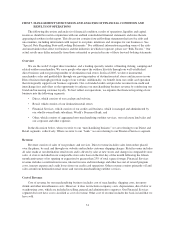Cabela's 2005 Annual Report Download - page 38
Download and view the complete annual report
Please find page 38 of the 2005 Cabela's annual report below. You can navigate through the pages in the report by either clicking on the pages listed below, or by using the keyword search tool below to find specific information within the annual report.correlated with customer loyalty to our merchandising businesses and to the strength of the Cabela’s brand. In
addition, transactions on cardholder accounts produce loyalty points which the cardholder may apply to future
purchases from us. Adverse changes in the desirability of products we sell, negative trends in retail customer
service and satisfaction or the termination or modification of the loyalty program could have a negative impact
on our bank subsidiary’s ability to grow its account base and to attract desirable co-branding opportunities with
third parties.
Changes in interest rates could have a negative impact on our earnings.
In connection with our financial services business, we borrow money from institutions and accept funds by
issuing certificates of deposit, which we then lend to cardholders. We earn interest on the cardholders’ account
balances, and pay interest on the certificates of deposit and borrowings we use to fund those loans. Changes in
these two interest rates affect the value of the assets and liabilities of our financial services business. If the rate of
interest we pay on borrowings increases more (or more rapidly) than the rate of interest we earn on loans, our net
interest income, and therefore our earnings, could fall. Our earnings could also be adversely affected if the rates
on our credit card account balances fall more quickly than those on our borrowings. In addition, as of the end of
fiscal 2005, approximately 38.9% of our cardholders did not maintain balances on their credit card accounts. We
do not earn any interest from these accounts but do earn other fees from these accounts such as VISA interchange
fees. In the event interest rates rise, the spread between the interest rate we pay on our borrowings and the fees
we earn from these accounts may change and our profitability may be adversely affected.
The VISA interchange litigation could adversely impact the amount of revenue generated by our
financial services business.
Groups of small and large merchants have recently sued VISA alleging, among other things, that VISA and
its member banks have violated U.S. antitrust laws by conspiring to fix the level of interchange fees. To date, we
have not been named as a defendant in any interchange lawsuits. If the VISA interchange fees that are charged to
merchants are reduced as a result of the interchange lawsuits, the amount of revenue our financial services
business generates through collecting interchange fees may be negatively impacted.
Fluctuations in the value of our interests in our securitizations relating to our financial services
business may adversely affect our earnings.
In connection with our securitizations relating to our financial services business, we retain certain interests
in the assets included in the securitization. These interests are carried in our consolidated financial statements at
fair value and include our retained interest, or a “transferor interest,” in the securitized loans, an “interest-only
strip” which represents our right to receive excess cash available after repayment of all amounts due to the
investors, and in some cases Class B certificates which are subordinate to the investors certificates. The fair value
of these retained interests depends upon income earned on these interests which is affected by many factors not
within our control, including the performance of the securitized loans, interest paid to the holders of
securitization securities, credit losses and transaction expenses. The value of our interests in the securitizations
will vary over time as the amount of loans in the securitized pool and the performance of those loans fluctuate.
The performance of the loans included in our securitizations is subject to the same risks and uncertainties that
affect the loans that we have not securitized, including, among others, increased delinquencies and credit losses,
economic downturns and social factors, interest rate fluctuations, changes in government policies and
regulations, competition, expenses, dependence upon third-party vendors, fluctuations in accounts and account
balances, and industry risks.
ITEM 1B. UNRESOLVED STAFF COMMENTS
None.
26
























